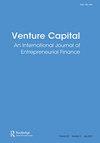Linear and non-linear patterns of internationalisation and funding in academic spin-offs
IF 2.3
4区 管理学
Q2 BUSINESS, FINANCE
引用次数: 2
Abstract
ABSTRACT Academic spin-offs (ASOs) are typically technologically driven, and their expansion into foreign markets has become a priority for the generation of revenue, thereby recuperating the initial R&D and patent costs over a shorter time frame. However, the literature of how these firms internationalise and what sources they can rely on to obtain the financial resources remains very limited. Two main objectives are proposed in this paper: first, the analysis of whether those relationships that ASOs maintain with various agents to provide financial resources for internationalisation differ between ASOs that have internationalised and those that have not; and second, the study into whether those ASOs that internationalise by following different internationalisation patterns present differences in their agents that provide them with financial resources. From a sample of 173 Spanish ASOs, results of cluster analysis and post-hoc tests indicate that internationalised ASOs rely on financial agents different to those of domestic ASOs. We firstly conclude, that the most representative internationalisation pattern in ASOs is Born Global (BG), through the True Born Global (TBG) and Sporadic Born Global (SBG) sub-patterns. Second, the internationalisation patterns are supported by different financial agents, although governmental institutions and Venture Capital (VC) firms constitute the most relevant agents.国际化的线性和非线性模式及学术衍生产品的资助
学术衍生产品(ASOs)通常是由技术驱动的,它们向国外市场的扩张已经成为产生收入的优先事项,从而在较短的时间内收回最初的研发和专利成本。然而,关于这些公司如何国际化以及他们可以依靠什么来源来获得财务资源的文献仍然非常有限。本文提出了两个主要目标:第一,分析已国际化和未国际化的自治组织与各种代理保持的为国际化提供财务资源的关系是否存在差异;第二,研究那些遵循不同国际化模式进行国际化的自治组织在为其提供财务资源的代理人方面是否存在差异。从173个西班牙自治组织的样本中,聚类分析和事后检验的结果表明,国际化自治组织对金融代理的依赖不同于国内自治组织。我们首先得出结论,ASOs中最具代表性的国际化模式是天生全球化(BG),通过真正的天生全球化(TBG)和零星的天生全球化(SBG)子模式。第二,尽管政府机构和风险投资公司构成了最相关的代理机构,但国际化模式得到了不同金融代理机构的支持。
本文章由计算机程序翻译,如有差异,请以英文原文为准。
求助全文
约1分钟内获得全文
求助全文
来源期刊

Venture Capital
BUSINESS, FINANCE-
CiteScore
4.10
自引率
16.70%
发文量
21
期刊介绍:
Venture Capital publishes cutting edge research-based papers from academics and practitioners on all aspects of private equity finance such as: •institutional venture capital •informal venture capital •corporate venture capital •public sector venture capital •community venture capital It also covers all aspects of the venture capital process from investment decision to exit, including studies on: •investment patterns •investment decision-making •investment performance •realisation of investment value exit routes (including the relationship with junior capital markets such as NASDAQ, EASDAQ, AIM and Nouvelle March). •economic impact and public policy
 求助内容:
求助内容: 应助结果提醒方式:
应助结果提醒方式:


